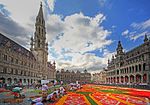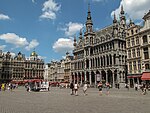Maison de l'Agneau Blanc
1696 in EuropeArt by Peter Van DievoetBaroque architecture in BelgiumBelgian building and structure stubsProtected heritage sites in Brussels

The Maison de l'Agneau Blanc (lit. 'House of the White Lamb') or simply l'Agneau Blanc is a baroque house, built in 1696, located at number 42 of the rue du Marché aux Herbes (lit. 'Herb Market Street') in Brussels, parallel to the Grand Place. The sculptures on the facade are the work of Peter Van Dievoet, commissioned by Jean De Broe.It has been a protected heritage site since 2011.
Excerpt from the Wikipedia article Maison de l'Agneau Blanc (License: CC BY-SA 3.0, Authors, Images).Maison de l'Agneau Blanc
Rue du Marché aux Herbes - Grasmarkt, City of Brussels Pentagon (Brussels)
Geographical coordinates (GPS) Address External links Nearby Places Show on map
Geographical coordinates (GPS)
| Latitude | Longitude |
|---|---|
| N 50.84766 ° | E 4.35278 ° |
Address
L'Agneau Blanc - Het Wit Lammeke
Rue du Marché aux Herbes - Grasmarkt 42
1000 City of Brussels, Pentagon (Brussels)
Belgium
Open on Google Maps











